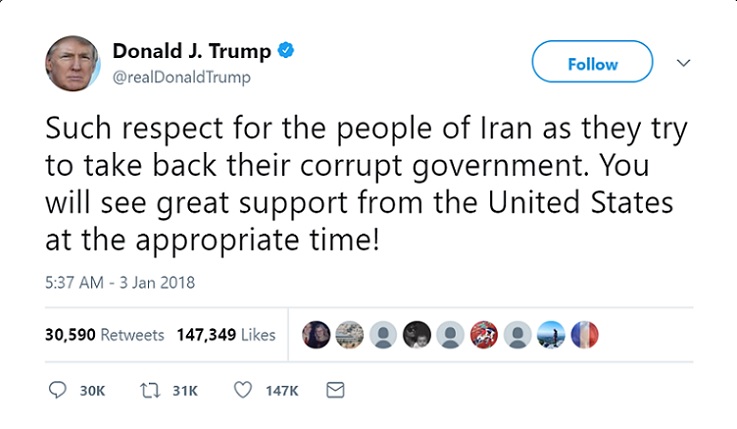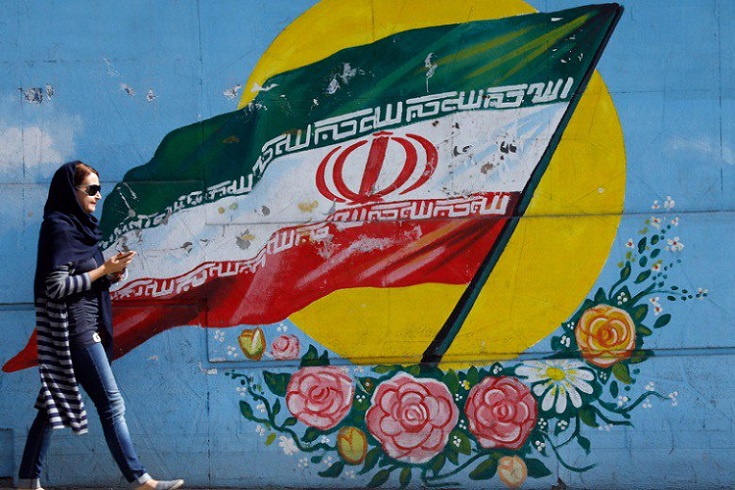Now we know that the protests that began in the Iranian Razavi Khorasan Province at the very end of December and that were quick to spread all over the country were provoked by repeated calls for acts of civil disobedience voiced by anonymous provocateurs on the Telegram. The absolute majority of international media sources was quick to point out that by pulling the strings those unnamed puppeteers managed to trigger one of the gravest political crises that Iran has seen in a decade.
As it’s been noted by the Der Spiegel, for a regime that seemed to be more confident in its stability than ever, the largest outburst of protests since 2009 turn out to be a complete shock. Back then millions of Iranians took to the streets, protesting against alleged voter fraud instances that allowed Mahmoud Ahmadinejad to secure his post. The prominent German media source notes that by judging by the videos depicting protests in Iran one can spot the growing social inequality in the country.
In turn, the Asia Times would go even further by stating that:
Inflation is high at 12% but down from 40% at the start of Rouhani’s first term. And the recent increase in fuel and food prices by up to 40% has hardly helped. That was part of Team Rouhani’s 2018 budget, which cuts subsidies for the poor – a key feature of the previous Ahmadinejad administration
Then there is youth unemployment, which hovers around the 30% mark. Of course, that explains why the bulk of the protesters are under 25 from working class backgrounds.
Iran’s daily newspaper Donya-e-Eqtesad seems to be convinced that a number of unpopular decisions made by the government in the field of socio-economic reforms is the main driving force behind the recent outburst of protests.
Yet another Iranian media source that goes under the name of Farda in its article “A look at the unrest through the eyes of an optimist”, notes that such social cataclysms assist the government in identifying true friends and enemies of the Islamic revolution. Farda adds that it it turns out that both conservative and progressive forces that can often criticize each other, have now come united to push back a common enemy that aims at bringing the government down.
The well-respected national newspaper Ettela’at would cite the head of the Tehran province Justice Department, Ghulam Hussain Ismaili who is convinced that authorities must obey Iranian laws to the letter while making attempts to restore public order across the country.
All of the Iranian media sources agree that we’re witnessing is a concerted attempt to turn legitimate protests into a “revolutionary” movement with the aim of bringing about a regime change. It’s been noted by the authorities that both eyewitnesses and video records of the protests show that crowds of protesters were infiltrated by professional agitators that would be screaming political demands in an attempt to outrage those who assembled peacefully. All of these fact may lead us to the conclusions that the protests themselves were nothing but a carefully staged show.
Iranian news agency IRNA has boldly described Riyadh, Washington and Tel-Aviv as the driving force behind the recent protests in Iran.
Iran’s Attorney-General, Mohammad Jafar Montazeri has already named US foreign intelligence officer Michael D’Andre along with one of Mossad’s officers as the masterminds behind this latest protest outburst in Iran, as it’s been noted by Al Jazeera. Unsurprisingly, all of the expenses suffered by those staging this latest coup attempt would be paid by Saudi Arabia.
According to the Javan media source, Washington will clearly be disappointed in the aftermath of its plan, while disagreeing with those assessments that Western media sources have been providing along with the statements made by the Trump administration about its alleged readiness to assist the people of Iran in the “fight against despotism.”

A lot of still sane European analysts were quick to point out that one can only hope that Iranian authorities will choose a cool-headed approach, since Europe is going to be the ultimate loser should the things in Iran go south. The population of Iran is reaching 81.5 million people, which is 1.5 times more than the prewar populations of Syria and Iraq combined. Should the West try to transform protests in Iran into violent clashes than the EU will witness a migrant crisis the scale it could never fathom. The most peculiar aspect of all of these developments is that this time Shia Muslims are going to flee the Middle East, in sharp contrast to all of the previous migrant waves, that were predominately Sunni. So if Brussels will fail to approach the situation in Iran cautiously, it’s going to witness new instances of confessional violence on its own soil pretty soon.
The Guardian would note that countless rivals of Iran are circling high in the desert sky, while watching the street protests in Tehran and other cities with beady-eyed anticipation. However, this media source is also consistent enough to note that American, Saudi and Israeli hawks should be careful about what they wish for, since the price of a regime change in Iran can be too high for anybody to pay.
Grete Mautner is an independent researcher and journalist from Germany, exclusively for the online magazine “New Eastern Outlook.”

